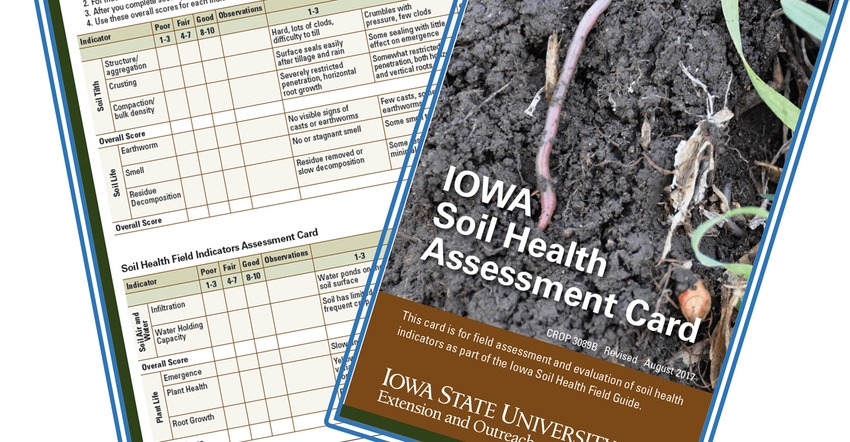December 18, 2017

By Marty Adkins
I had my yearly medical checkup last week. It was a routine visit, time to have prescriptions refilled and get my flu shot. It was also a good time to chat with my doctor about my overall health and to ask questions.
As we round the corner from one crop year to the next, it’s a good opportunity to conduct a “checkup” of soil health, too. Only living things can have health, and soils are amazing, complex living ecosystems. Soils are home to organisms that cycle nutrients, build water-holding capacity and help make soils “spongy” to capture precipitation. And remember, the health of the soil on your farm will affect the health of your bank account, now and in the future.
Check key soil health indicators
The Iowa Soil Health Assessment Card is a helpful tool for assessing soil health. Use the card, and a spade, to check on some key soil health indicators:
• Root growth. Are roots growing vertically and penetrating into the soil with lots of fine roots? That’s a good sign. Roots traveling horizontally signal soil compaction, which limits root growth and crop yields.
• Soil structure. Does your soil have the look of cottage cheese, with stable aggregates and lots of pore space? If so, great! On the other hand, hard, massive clods indicate your soil structure needs attention.
• Water-holding capacity. Did water soak in or run off this past year? Did you have fields that experienced drought stress earlier than expected? If so, it’s likely time to rethink tillage practices that burn off water-storing organic matter.
Increase soil health using key principles
To build soil health, keep in mind the following principles:
• Minimize soil disturbance. Over time, tillage reduces soil’s ability to soak in and hold water. It also leaves soil susceptible to erosion and nutrient loss.
• Maintain plant diversity. Do it through use of crop rotations and cover crops. Plant diversity leads to more diversity in soil microorganisms and helps break up disease and pest cycles.
• Living roots growing throughout year. They will feed soil microorganisms and keep nitrates in the root zone where they can be used in the next crop.
• Keep the soil covered. Crop residue helps prevent erosion and moderates root zone temperatures. Crop residues left on the soil surface will decompose in place, helping to build soil organic matter.
Remember, checkups aren’t just for people. Monitoring and working to improve soil health is important for your farm, too.
The Iowa Soil Health Assessment Card is available from Iowa State University Extension. It can be downloaded for free from the ISU Extension Store. The card, listed as publication 3089B, is for field assessment and evaluation of soil health indicators as part of the Iowa Soil Health Field Guide.
The rating descriptions for each indicator presented on the scorecard represent the worst and best soil conditions at the time of evaluation. As the Iowa Soil Health Assessment Card is used over time, the impact of different management systems can be documented.
Adkins is assistant state conservationist for USDA’s Natural Resources Conservation Service in Iowa, and is a member of the Iowa Learning Farms steering committee.
You May Also Like




